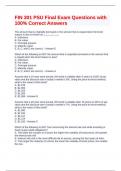Exam (elaborations)
FIN 301 PSU Final Exam Questions with 100% Correct Answers
- Course
- Institution
The amount that is originally borrowed or the amount that is repaid when the bond mature is due is known as ___________. A. Indenture. B. Par value. C. Principal amount. D. Maturity value. E. B, C, and D are correct. - Answer-E Which of the following is NOT the amount that is originall...
[Show more]



